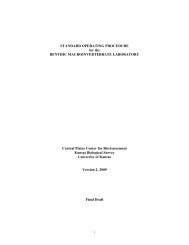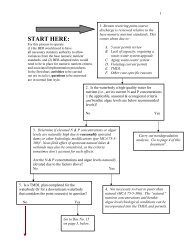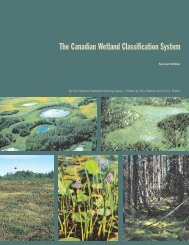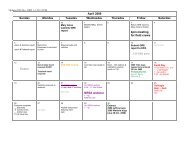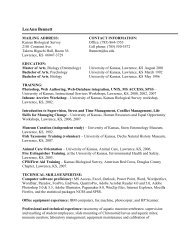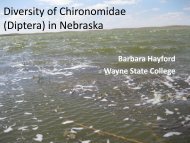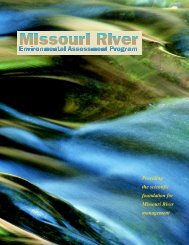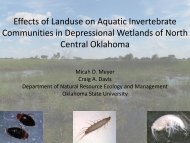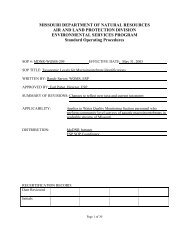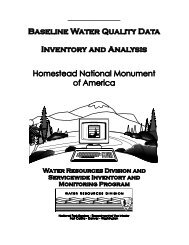1.83 MB
1.83 MB
1.83 MB
Create successful ePaper yourself
Turn your PDF publications into a flip-book with our unique Google optimized e-Paper software.
Big Muddy Bioassessment:<br />
Can Biocriteria be Developed<br />
for the<br />
Lower Missouri River <br />
Barry C. Poulton – U.S. Geological Survey<br />
Randy J. Sarver – Missouri Dept. of Natural Resources<br />
River Studies Station<br />
Columbia Environmental Research Center
Past<br />
Brief Overview of LMR Macroinvertebrate Studies<br />
Characterize community in different habitats & substrate types<br />
Examine efficiency and suitability of sampling methods<br />
Current<br />
Identify longitudinal effects from cumulative water quality impacts<br />
Validate large river metrics & identify longitudinal response gradients<br />
Future<br />
Evaluate biological condition and water resource status<br />
Develop large river biocriteria and relate to aquatic life use attainment
Alterations in “Great” Rivers<br />
Habitat & Substrate Distribution (Relative Contribution)<br />
Organic Matter (Storage, Transport, Entrainment)<br />
Hydrology (Flow Regime, Depth & Velocity)<br />
Cumulative Urban (CSO’s, Wastewater, Contaminants)<br />
Collective Agricultural (Contaminants, Nutrients)<br />
Lower Missouri River (1211 km or 752 miles)
Sioux City<br />
Macroinvertebrate<br />
Sampling Locations<br />
Omaha<br />
Iowa<br />
Nebraska<br />
Kansas<br />
Missouri<br />
St. Joseph<br />
Kansas City<br />
St. Louis<br />
Jefferson City<br />
100 kilometers
Why Large River Bioassessment / Biocriteria <br />
Water Resources Status Reporting (CWA, etc)<br />
Aquatic Life - Designated Use Support (Health)<br />
Realistic Benchmarks for Recovery & Rehabilitation<br />
Track Community Changes due to Exotic Species<br />
Relationship to Important Vertebrate Species
Summary of Large River Biocriteria Issues<br />
1. Basic Ecological Knowledge of Fauna<br />
2. Sampling Methods / Habitats<br />
3. Index Period<br />
4. Statistical Design & Analysis<br />
5. Degree of Similarity with Wadeable Streams<br />
6. Response Attributes (Metrics)<br />
7. Metric Expectations (Reference )
Typical habitats within a meander segment<br />
Outside Meander<br />
Rock Revetment<br />
Channelized Lower Missouri River<br />
Depositional Mud<br />
Behind Wing Dikes<br />
Snags<br />
(Organic Matter)<br />
Channel Border<br />
Sand Bar Complex<br />
Valley Wall<br />
Natural Rock
Rock Revetment, located on<br />
outside bend of a meander
Depositional Mud, located<br />
behind wing dike
Justification for Selection of the 2 LMR Habitats<br />
1. coarse substrate (revetment) 2. depositional mud (dike fields)<br />
Same as for bioassessments in wadeable streams / small rivers<br />
Habitats are repeatable and have distinct composition<br />
Sampling methods used are well-established and reliable for LMR<br />
Many widely-used metrics were developed specifically for them<br />
Most significant, most stable, and highest species richness<br />
High frequency allows randomization within relatively short reaches
Percent (%) of Taxa Richness in 4 Substrate Types Lower<br />
Missouri River - mainstem<br />
100%<br />
80%<br />
60%<br />
40%<br />
20%<br />
Other<br />
Chiron<br />
Trichop<br />
Odonat<br />
Plecop<br />
Ephem<br />
0%<br />
Rock Mud Sand Organic Total<br />
78 69<br />
12 30 132<br />
49 21 4<br />
2<br />
21<br />
Total Species<br />
Unique Species
Two Examples of Rare and Unique Macroinvertebrate Taxa Restricted to Large Rivers<br />
Attaneuria ruralis<br />
Pseudiron centralis
Taxa Distribution in 2 Habitats – Lower Missouri River<br />
9<br />
18<br />
13<br />
EPOT<br />
Chironomidae<br />
E - 24<br />
P - 11<br />
O - 9<br />
T - 13<br />
57<br />
Rock Basket & Kick Net<br />
(Coarse Substrate)<br />
9<br />
24<br />
Non-Insect<br />
Other<br />
12<br />
E - 9<br />
P - 3<br />
O - 2<br />
T - 10<br />
24<br />
Petite Ponar<br />
(Depositional Mud)
Summary - Currently Funded LMR Study<br />
Goal<br />
Establish longitudinal response gradient to validate endpoint metrics<br />
18 sites, 2 habitats, 3 methods, Autumn index period<br />
Simultaneous basic water quality and sediment contaminants<br />
Sampling Design & Approach<br />
upstream/downstream site selection based on longitudinal features<br />
(urban areas, tributaries), with pre-stratification by habitat<br />
“Site” Definition<br />
A 10 km reach that includes repetition of the 2 selected habitats
LMR Macroinvertebrate Bioassessment - Assumptions Made<br />
A.<br />
B.<br />
C.<br />
D.<br />
E.<br />
Wadeable stream approaches will work with some<br />
modifications or adjustments<br />
Some reliable metrics used in wadeable streams tell us<br />
the same story when used in large rivers<br />
Communities in “Great” rivers must be viewed as<br />
integrators of all combined or cumulative stressors<br />
Cumulative effects of perturbations can be separated<br />
from other effects (biogeography, geology, lattitude)<br />
Each “Great” river needs to be evaluated individually
One Possible Approach for Assessment of Large River Sites<br />
Metric Value, Condition Score, or % of Reference<br />
Benchmark (State Criteria Based on Reference EDU or Highest Attainable Value)<br />
75 th Percentile<br />
Best Value for a Missouri River Site or Reach Based on Large Number of Sites<br />
50 th Percentile<br />
25 th Percentile<br />
Sites To Be Evaluated<br />
1 2 3 4 5 6 7 8
List of Candidate Metrics – LMR Macroinvertebrates<br />
*<br />
*<br />
*<br />
*<br />
Total Taxa Richness<br />
EPT (% and richness)<br />
% Chironomidae<br />
% Ephemeroptera<br />
Hilsenhoff Biotic Index<br />
Shannon-Wiener Diversity Index<br />
Scraper/Filtering Collector Ratio<br />
Density (# / m 2 )<br />
% Dominant Taxon<br />
EPT/Chironomidae Ratio<br />
*<br />
*<br />
*<br />
*<br />
*<br />
*<br />
EPOT (% and richness)<br />
% Filtering Trichoptera<br />
% Large River Taxa<br />
Chironomidae Taxa Richness<br />
% Oligochaeta<br />
For Coarse Substrate (Rock)<br />
For Depositional Substrate (Mud)<br />
For Both Substrates<br />
Response trend or statistical significance<br />
among sites detected in pilot study
Percent (%) Ephemeroptera<br />
8<br />
7<br />
6<br />
5<br />
4<br />
3<br />
2<br />
1<br />
Percent (%) Mayflies for 6 LMR sites<br />
Petite Ponar data from 1996<br />
50 th Percentile<br />
25 th Percentile<br />
0<br />
Nebraska City<br />
(RM 559)<br />
St. Joseph<br />
(RM 505)<br />
Parkville<br />
(RM 377)<br />
Sites Above Kansas City Metro Area<br />
Lexington<br />
(RM 319)<br />
Glasgow<br />
(RM 228)<br />
Hermann<br />
(RM 93)<br />
Sites Below Kansas City Metro Area
Relative score for 6 LMR sites – Biotic Condition<br />
60<br />
Rock basket data and 10 macroinvertebrate metrics<br />
50<br />
10-Metric Score<br />
40<br />
30<br />
20<br />
50 th Percentile<br />
25 th Percentile<br />
10<br />
0<br />
Nebraska City<br />
(RM 559)<br />
St. Joseph<br />
(RM 505)<br />
Parkville<br />
(RM 377)<br />
Sites Above Kansas City Metro Area<br />
Lexington<br />
(RM 319)<br />
Glasgow<br />
(RM 228)<br />
Hermann<br />
(RM 93)<br />
Sites Below Kansas City Metro Area
Summary – What we know so far about Big Muddy Bioassessment<br />
Habitats / substrates are distinct and longitudinally repeatable,<br />
and can be successfully sampled using standard methods<br />
Community contains both generalists and habitat specialists,<br />
including some taxa that are restricted to large rivers<br />
Even though most of the rock has been artificially added, it<br />
contains the most diverse macroinvertebrate communty<br />
Site assessment possible with standard metrics and approaches,<br />
but modifications or adjustments needed are not well understood<br />
Relative biological condition among sites can be evaluated, but<br />
“best value” may need to be used for reference benchmark
LMR Future Research Needs<br />
Validation of large river metrics – include<br />
simultaneous measurements of sediment<br />
and water quality indicators<br />
Higher site density – 50 or more<br />
Biological condition gradient tiers<br />
need to be developed<br />
Biological response signatures<br />
need to be identified<br />
Multi-state consortium – implementation



